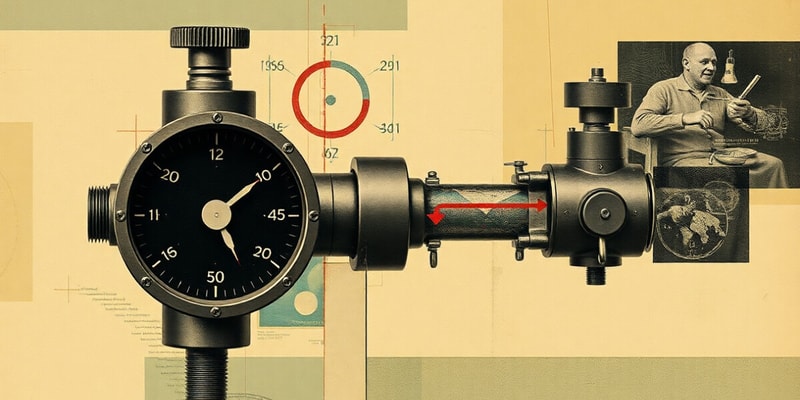Podcast
Questions and Answers
What is the main function of the Pressure Regulating Valve (PRV)?
Which component provides reverse flow protection in the pressure regulating system?
How is the Pressure Regulating Valve (PRV) controlled?
What is the default state of the Over Pressure Valve (OPV)?
Signup and view all the answers
What component is used for monitoring and indicating the position of the PRV?
Signup and view all the answers
Where is the Thermostat control Solenoid (ThS) installed in relation to the precooler exchanger?
Signup and view all the answers
How is muscle pressure for the actuation of the OPV achieved?
Signup and view all the answers
What type of transducer is used in the bleed regulated pressure transducer?
Signup and view all the answers
What is the primary function of the PRV in regulating downstream static pressure?
Signup and view all the answers
Under which condition does the BMC close the PRV?
Signup and view all the answers
How does the OPV provide backup protection against overpressure conditions?
Signup and view all the answers
At what minimum upstream pressure will the PRV begin to open?
Signup and view all the answers
What happens if the temperature downstream of the precooler exceeds 235 degrees Celsius?
Signup and view all the answers
During which operational condition does the PRV function?
Signup and view all the answers
Which component is responsible for detecting an overpressure condition?
Signup and view all the answers
What is the maximum regulated pressure that the PRV will allow downstream?
Signup and view all the answers
What triggers the closure of the PRV in the engine bleed system?
Signup and view all the answers
Under what condition can the BMC automatically isolate engine bleed air supply?
Signup and view all the answers
What is the role of the regulated pressure transducer in the bleed system?
Signup and view all the answers
What position is indicated to the BMC by the 'FC/NOT FC' microswitch?
Signup and view all the answers
How can the engine bleed system be manually isolated?
Signup and view all the answers
When does the engine bleed valve remain closed?
Signup and view all the answers
What happens to the engine bleed system if an engine fire occurs?
Signup and view all the answers
What is indicated on the ECAM BLEED page?
Signup and view all the answers
Study Notes
Pressure Regulating Valve (PRV)
- The PRV regulates engine bleed pressure.
- It's a butterfly valve controlled by a thermostat solenoid (ThS).
- The ThS is connected to the PRV by a pneumatic sense line.
- The PRV is normally closed by a spring-loaded mechanism.
- It requires a minimum upstream pressure of 8 psi to open.
- The PRV regulates downstream static pressure between 44 psi and 52 psi maximum.
- The PRV closes when the temperature downstream of the precooler exchanger exceeds 235 degrees Celsius.
Overpressure Valve (OPV)
- The OPV protects the downstream pneumatic system if the PRV malfunctions.
- It's a pneumatically actuated valve that's normally open.
- It closes when upstream pressure exceeds 75 psi and fully closes at 85 psi.
- The OPV remains closed as long as upstream pressure is higher than 52 psi.
Bleed Regulated Pressure Transducer
- It's a silicon-type transducer connected to a pressure tapping downstream of the system.
- It monitors bleed pressure and provides information for fault isolation regarding the PRV and OPV.
Pressure Regulation System
- The PRV is normally spring-loaded closed, requiring a minimum upstream pressure of 8 psi to open.
- The PRV controls downstream static pressure, maintaining it between 44 psi and 52 psi.
- The ThS controls the PRV when the temperature downstream of the precooler exchanger is higher than 235 degrees Celsius.
Overpressure Protection
- The BMC detects overpressure conditions when bleed regulated pressure exceeds 60 psi.
- The BMC closes the PRV and displays a warning message on the EWD.
- The BLEED page on the SD displays the HPV and PRV closed in amber.
- The OPV provides a fully pneumatic backup protection in case of PRV failure.
Bleed System Isolation Function
- Each engine bleed system can be isolated from the pneumatic manifold by closing the PRV.
- This can be done manually by releasing the corresponding BLEED P/B on the AIR panel or automatically by the BMC.
Automatic Isolation
- The BMC can automatically isolate engine bleed air supply by energizing the ThS in several scenarios:
- If a pylon or wing leak is detected.
- If an overpressure condition occurs.
- If an over-temperature condition occurs.
- During engine start.
- During APU bleed supply.
Manual Isolation
- The engine bleed system can be isolated manually from the pneumatic manifold by releasing the corresponding BLEED P/B on the AIR panel.
Monitoring
- The bleed regulated pressure transducer is used for monitoring and fault isolation regarding the PRV and OPV.
- A fault message is sent to the ECAM and CMS for maintenance purposes.
Fire Isolation
- In case of an engine fire, the bleed system is isolated by releasing the corresponding FIRE P/B on the overhead panel.
- The ECAM BLEED page shows the position of the PRVs.
Studying That Suits You
Use AI to generate personalized quizzes and flashcards to suit your learning preferences.
Related Documents
Description
This quiz covers the functioning of Pressure Regulating Valves (PRV) and Overpressure Valves (OPV) in engine systems. It includes details about their operational mechanisms, interactions, and pressure specifications. Test your knowledge on the technical aspects of regulating engine bleed pressure.




